Some of the most common fish in Ohio are carnivores. They only eat other fish and worms. Others are insectivores while a small number of species are planktivores.
The Northern opening to Lake Erie and The Great Lakes makes Ohio one of the states with a considerable mix of native and invasive fish.
Small and large species are found here. Some of the fish in Ohio are even traced to prehistoric species which go back more than 16 million years ago, such as Redear Sunfish.
The following species of fish are found in Ohio’s lakes, streams, reservoirs, canals, and rivers. They are adapted to the cold winters of the North and tend to become very active from spring onwards.
Table of Contents
1. Bluegill

Bluegill (Lepomis macrochirus) is one of the most common types of fish in Ohio.
This is a colorful freshwater species found in lakes, ponds, rivers, and streams. It’s a fairly-sized species that may reach a size of up to 12 inches.
Bluegill has purple and blue head coloring and gill covers.
Olive and orange are the main colors of bluegills. Dark olive to black bands is seen across the body on some morphs synchronized with the environment of the fish.
Fish of this species are known for having different swimming adaptations such as the capacity to swim backward.
This species eats all types of foods such as aquatic insects.
Bluegill is also one of the most important foods for bass.
2. Largemouth Bass

Largemouth Bass (Micropterus salmoides) is one of the largest species in Ohio.
It can reach a maximum size of nearly 30 inches and having a large mouth means this fish has a very varied diet.
A dark olive and gray color with darker patterns are specific to Largemouth Bass.
As a true predator, Largemouth Bass is known for showing plenty of resistance to angles.
In the Northern parts of the state and Lake Erie, Largemouth Bass are important predators of invasive species such as the Round Goby.
Largemouth Bass can also show invasive traits, but only in introduced areas around the world.
The high density of water vegetation is one of the most pressing problems for Largemouth Bass which cannot catch prey efficiently in these overgrown areas.
3. Green Sunfish

This fish (Lepomis cyanellus) has a green or green-gray color with yellow ventral colors and blue marks on the gills.
Many Green Sunfish are caught by fishermen by accident when looking to catch larger fish due to their common nature.
This is a species adapted to lakes and ponds as slow-moving waters are ideal for the species. It also makes it a good choice as an aquaria species.
These types of fish are also found in many ponds as they show high adaptability to less-than-ideal conditions and even in muddy waters.
Bloodworms are part of its diet together with waxworms and other types of worms.
4. Creek Chub

Creek Chub fish (Semotilus atromaculatus) have a green-gray or brown-gray color. The size of the species is generally small but they can reach up to 12 inches.
Most Creek Chub fish are smaller, measuring between 2 and 4 inches on average.
The reduced size of the species often makes them ideal prey for birds, pike, and bass.
Creek Chub fish are omnivores themselves. They eat both fish and vegetation. Feeding time only beings in the second part of the day for the species.
5. European Carp

European Carp (Cyprinus carpio) is one of the most common species in lakes around Ohio.
This is one of the most introduced species around the world with a growing and stable presence across the state.
It lives in slow-moving waters such as lakes, preferably with vegetation.
European Carp can destroy native vegetation as they disturb the bottom sediments in lakes.
This is a species that has wide use in Europe and Asia fish consumption markets.
It doesn’t make the list of the most important fish in North America as it cannot be properly filleted due to its intra-muscular bones.
6. Rainbow Darter
Much of the habitat of Rainbow Darters (Etheostoma caeruleum) resembles the habitat of trout.
Unlike European Carp that live in small and large lakes, Rainbow Darters live in fast-moving streams and small rivers.
They prefer clean waters of these habitats and are highly impacted by pollution.
Rainbow Darters have multicolored bodies with distinct orange fins.
This is a small species growing to an average size of just 2 inches.
Excessive urbanization currently limits the numbers of this species both in the state and in other states.
7. Smallmouth Bass
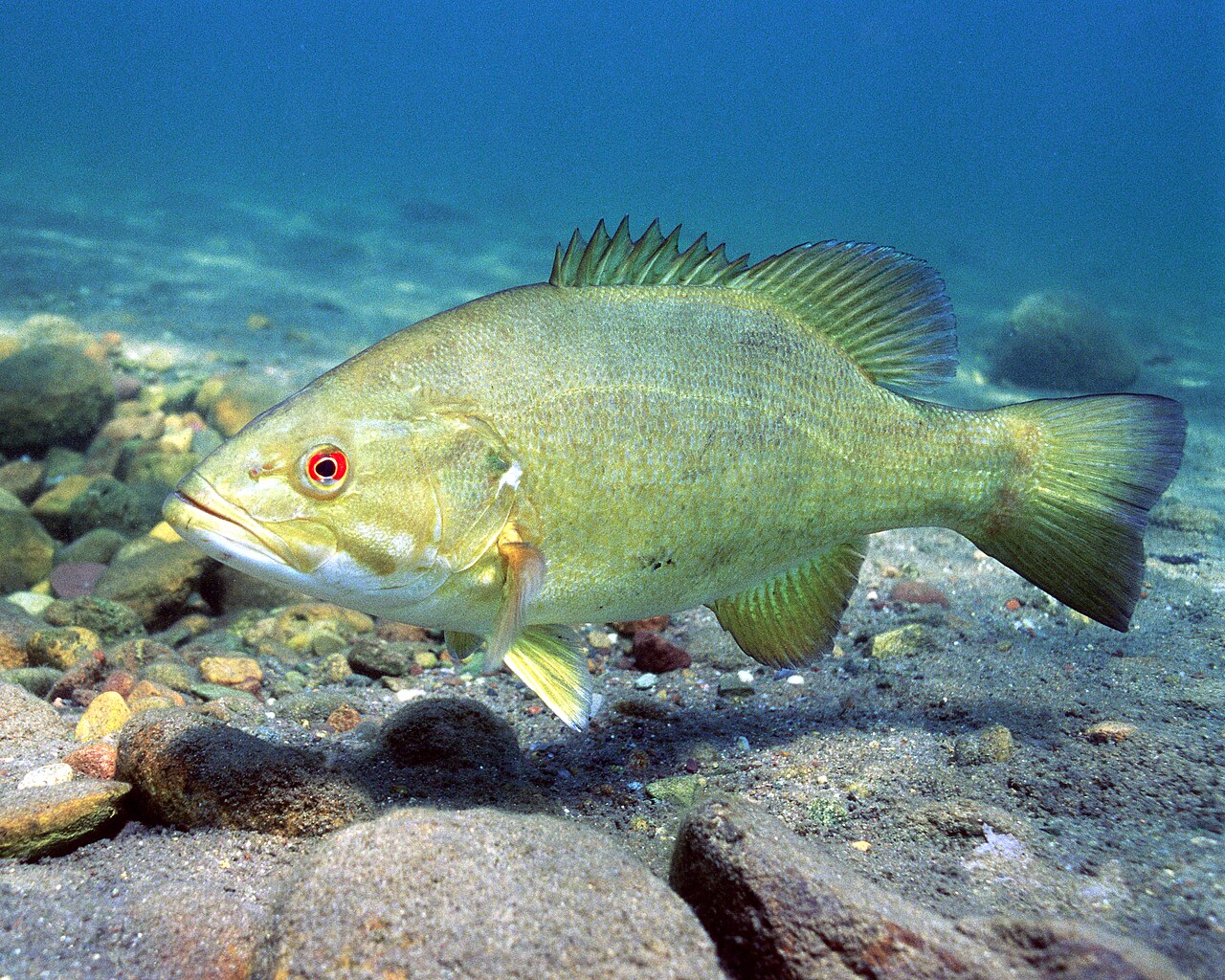
A common game fish, Smallmouth Bass (Micropterus dolomieu) is one of the multiple golden-olive species of Ohio.
It lives in streams and lakes but it’s also found in lakes, especially on the sandy bottoms of Lake Erie.
The species started to make its way East once the Erie Canal was constructed.
A fast-moving species, Smallmouth Bass becomes sluggish and almost doesn’t move at all in the winter. As soon as temperatures drop, it retreats to deeper water.
Crayfish and insects are part of its diet, together with different aquatic and non-aquatic insects.
8. Channel Catfish

Chanel Catfish (Ictalurus punctatus) is one of the most popular species with anglers in Ohio.
A species common in the area of The Great Lakes, the Chanel Catfish represent one of the important game fish species and a fish many eat.
The species has widespread distribution as it’s also grown as food in different commercial fisheries of the country.
Chanel Catfish have a varied diet themselves. Snails, fish, and even snakes can be eaten by this fish.
Its large size allows it to eat larger fish such as sunfish.
A weight of up to 50 pounds is not uncommon for Channel Catfish.
9. American Gizzard Shad

This species (Dorosoma cepedianum) comes in brown or gray dorsal color and gray ventral coloring with or without yellow sides.
American Gizzard Shad are a species of fish that lives in slow-moving waters such as in lakes or reservoirs.
Its presence in rivers and streams also makes this a species that expand beyond the borders of Ohio.
While they generally don’t impact their ecosystems as much as other fish, American Gizzard Shad fish may still impact plankton populations which reduces available food for filter feeders.
10. Western Blacknose Dace

This type of fish (Rhinichthys obtusus) has very small scales which makes it look like a smoother species compared to others in the state.
Its elongated moth helps quickly identify the species together with traits such as having a pink lateral stripe.
You can find this species in different areas with shrimp or other types of amphipods.
This species also feeds on different flies which also makes it one of the species which can be caught in fly fishing.
Luring these fish out of the rocky bottoms they hide in is the most difficult part of catching them.
11. Central Stoneroller
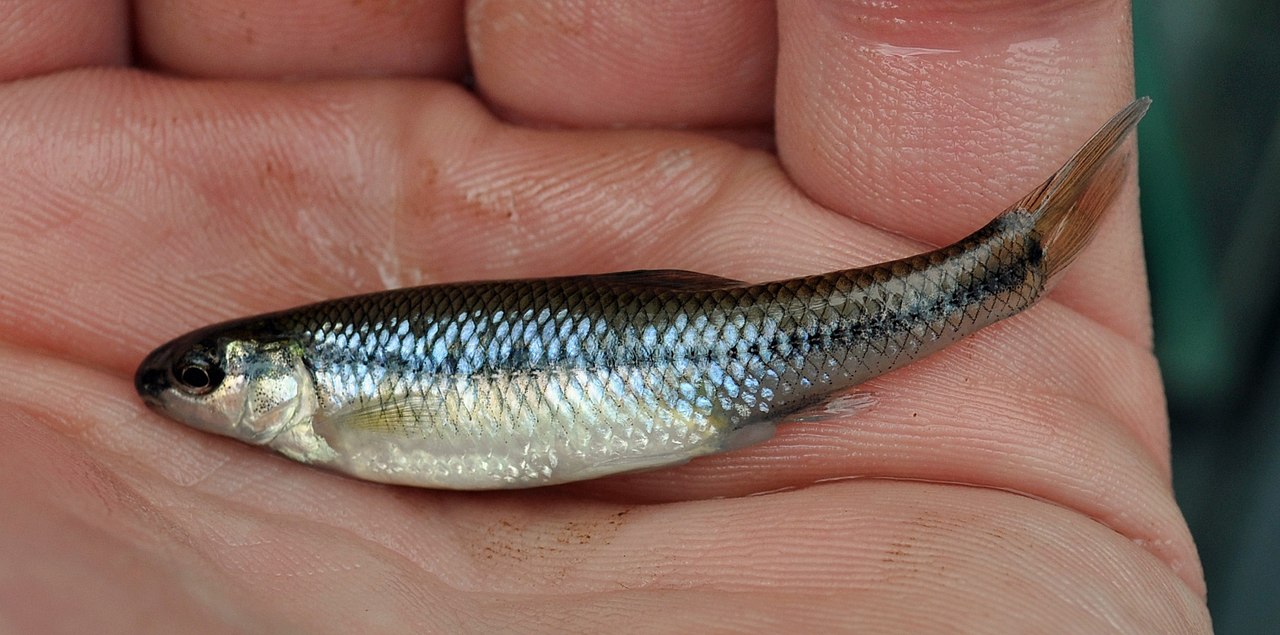
This gray and white fish (Campostoma anomalum) is found in streams and rivers of the state.
It has a very agile behavior and the capacity to roll stones at the bottom of rivers. This capacity also inspires its name.
Central Stonerollers move away stones to build nests for their eggs.
Its males are responsible for rolling the stones and creating a type of large burrow as they dig into the ground with their mouths.
It’s here that the female lays eggs. The male guards the eggs for a period before abandoning the nest, together with the female.
12. Bass

This species (Ambloplites rupestris) may be confused with smallmouth bass at first.
Smaller than other bass, Rocky Bass is found at the bottom of the shallow lake or river bottoms.
Pools and ponds with plenty of vegetation might also provide a suitable habitat for the species bred in captivity.
Rock Bass eats various types of insects and small fish. A cannibalistic behavior is specific to this species which can eat its young fish.
The reduced size of Rock Bass also makes it a common target for large predators.
Northern Park and Walleye are among the larger fish in the area of The Great Lakes that also eat Rock Bass.
13. Pumpkinseed

This type of small fish (Lepomis gibbosus) is one of the encountered species when fishing with worms.
It has a small body and a shape that reminds it of pumpkin seeds. Coloring can differ from a combination of orange, yellow, green, and red.
This small fish measures around 4 inches on average with only the largest recorded fish of the species measuring more than 10 inches.
A carnivorous species, this fish lives in ponds and small lakes.
It can sometimes be found at the bottom of the lake or the surface. It moves around for food.
The species tends to shy away from shallow lake waters where temperatures are normally higher.
14. Freshwater Drum

Freshwater Drum (Aplodinotus grunniens) is one of the species found in the area of The Great Lakes as well as in multiple rivers.
This is a species that competes for resources in these large Northern lakes with species such as yellow perch.
A freshwater Drum is a large fish that may sometimes reach a full size of 30 inches.
It’s the young stage of its life that marks the most sensitive period of its life as its seen as prey by various predators such as largemouth bass.
Freshwater Drum has a brown-gray or golden-brown color and it’s also a prized catch to anglers.
This species remains at the bottom of the lake where it feeds on other fish and larvae, among other types of food.
15. Black Crappie

Black Crappie fish (Pomoxis nigromaculatus) grow to a size of up to 10 inches. They come in various colors but a silver-gray morph with black mottling is common.
This is a flattened shape species that primarily feed on plankton.
It can be found in state lakes and reservoirs. Outside Ohio, the presence of the species is up for debate as it appears and disappears in areas it has been introduced.
This species sometimes overlaps the habitat of White Crappie.
Anglers looking to catch this fish may only do so in the evening and at midnight as Black Crappie fish don’t feed during the day.
16. Fantail Darter

This species (Etheostoma flabellare) is known for having fins that resemble eggs as they grow.
Fantail Darter fish live up to 4 years. It takes 1-2 years for them to mature and during this time, the fins of males resemble the eggs of the species the most.
A mottled brown and black color combination is specific to this species.
Northern Ohio and the area of The Great Lakes mark the Northern limit of the species in The United States.
Fish of this species may only eat insects and small larvae.
17. White Sucker

White Sucker fish (Catostomus commersonii) have a silver-gray to white color and are found at the bottom of lakes, ponds, and streams.
An adaptable species, White Sucker fish are among the species known to live in rivers and streams outside of their typical habitats in lakes.
These are a type of fish with an elongated body that measures anywhere between 11 and 20 inches.
A common catch to anglers, White Suckers are rarely kept as food. While some cultures use it for food, this is a species commonly used as bait for larger species.
The largemouth bass is one of the predators that often goes after White Sucker fish.
18. Greenside Darter
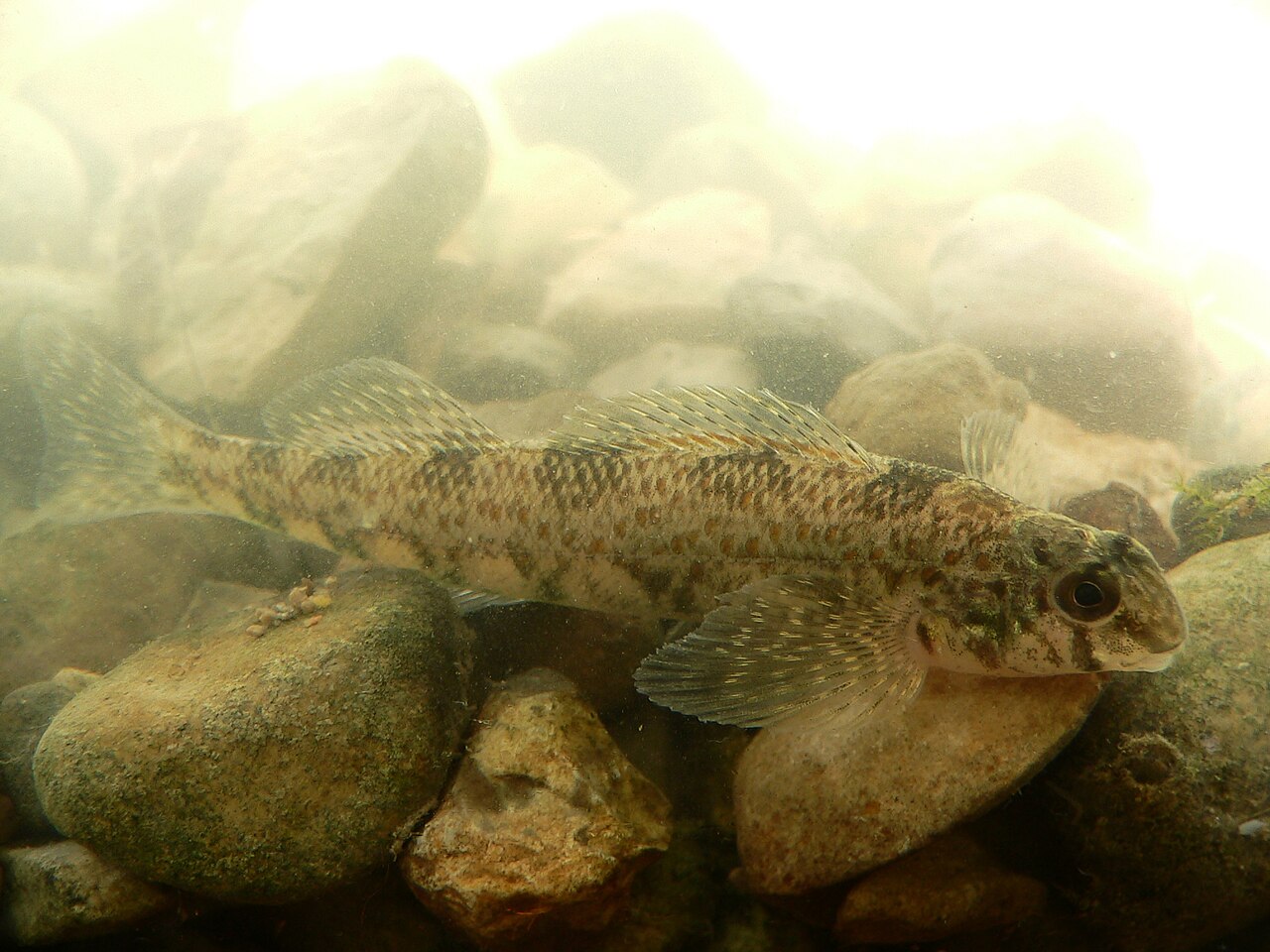
Greenside Darter (Etheostoma blennioides) is among the smallest green fish in Ohio.
This species only grows to a size of a few inches and inhabits small and medium-sized rivers.
It prefers the rockiest parts of rivers where it can survive and make a quick escape as needed.
This is a species that multiplies using algae. It’s also a species that takes on algae coloring as both its body and fins are partially green.
Yellow and golden nuances are further seen both across its body and on its fins.
19. Western Mosquitofish
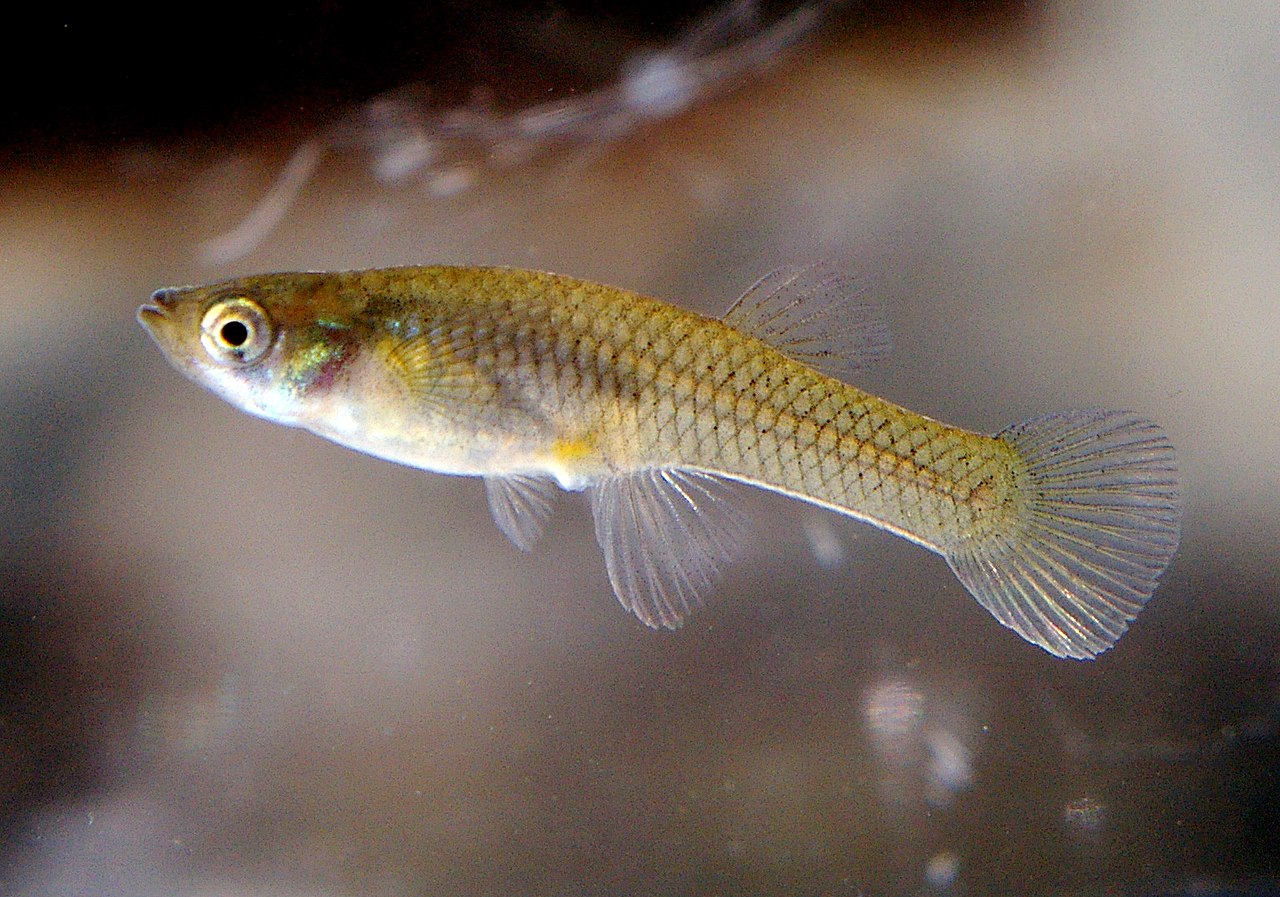
Western Mosquitofish (Gambusia affinis) are some of the most common small species of Ohio.
These fish measure anywhere between 1.8 and 3 inches and are known as the species that eat mosquito larvae.
While a generalist feeding, The Western Mosquitofish is mostly known for eating mosquito larvae. At the same time, this is a species that was also introduced around the world to lower mosquito populations.
Most attempts failed as it outcompeted local fish that ate mosquito larvae essentially increasing the number of mosquitoes in an area.
This is also a cannibalistic species often eating its young in the absence of insect larvae to feed on.
20. Rainbow Trout

Rainbow Trout (Oncorhynchus mykiss) is one of the most common species in the state both in lakes and in rivers as spawning areas.
This species has been introduced to The Great Lakes where it had a high survival rate and where it has adapted since.
It grows to a weight between 1 and 5 pounds on average with the largest Rainbow Trout even weighing up to 20 pounds.
This is a species that eat insects and larvae and which anglers often go after in fly fishing.
Rainbow Trout are also marked as one of the most important 100 invasive species of fish around the world as they outcompete many local fish.
Rainbow trout is one of the species that only live in clean waters always favoring bedrock and shallow streams and rivers in their upstream zone.
21. Johnny Darter

These small species of fish (Etheostoma nigrum) are found in lakes, reservoirs, and ponds.
A brown or yellow morph with black spots and transparent fins is characteristic of the species.
This is a small fish that may only grow to 1.5 inches.
Its reduced size makes it common prey for predatory fish and amphibians.
Trout such as lake trout are known to eat Johnny Darters. Fish of this species may only eat crustaceans.
Spawning takes place from May onwards. Male Johnny Darters first establish territories for spawning.
22. Mottled Sculpin

This species (Cottus bairdii) is named after its mottled appearance. Spots, lines, and speckles decorate its body.
Mottled Sculpins can have a yellow, a brown-yellow, or a brown color with dark gray, brown, or black mottling.
This is one of the smaller species of fish in Ohio, sometimes sharing its habitat with trout. The largest trout in the state are known to feed on Mottled Sculpins.
Other common predators of this species include the Smallmouth Bass.
This species is found at the bottom of lakes and rivers where they eat insects and their larvae.
Rocky rivers are preferred by the species and this is where males establish their spawning sites and nests by digging under rocks.
23. Bluntnose Minnow

These types of fish (Pimephales notatus) show their age by the number of rings seen on each scale.
A blue-gray or silver color is specific to Bluntnose Minnows.
While not the most common species in Ohio, Bluntnose Minnows are the most common type of fish in Eastern parts of The United States.
This is a small fish that only grow up to a few inches, sometimes used as bait for larger fish.
Insects and small crustaceans are among its preferred foods. Unlike most species in Ohio, Bluntnose Minnows aren’t carnivores as they also eat vegetation.
They inhabit warm shallow waters in lakes and rivers, especially in areas with sandy bottoms.
24. Striped Shiner

Striped Shiner fish (Luxilus chrysocephalus) are a small species found in rivers, particularly upstream.
These fish have a silver color in both sexes with a slight pink nuance in the case of males.
Striped Shiner are known as some of the most aggressive types of fish when it comes to male-to-male relationships.
They can be found fighting each other in spawning areas.
Rocky pools in clear upstream rivers or streams are the areas the species can be found spawning in the summer.
Striped Shiners are also established in The Great Lakes.
25. Yellow Bullhead

Found in The Great Lakes, Yellow Bullhead (Ameiurus natalis) represents one of the largest types of fish in Northern Ohio.
This species is known for its smooth appearance without fins. A dark gray-to-black color is specific to the species.
A true omnivore and even a scavenger, Yellow Bullhead fish eat live and dead fish. They also eat live and dead plants.
This species is considered a game fish, but not of great importance compared to other catfish.
While it is eaten, the fish is not the primary species to be consumed from The Great Lakes as it’s known for its rather soft texture.
26. Northern Hog Sucker

A multicolored mottled species, Northern Hog Suckers (Hypentelium nigricans) are known for their sucking-like feeding habit.
They have adapted to feeding on the bottom of lakes and rivers. Their mouth sucks nutrients covering rocks and sandy areas.
Fish of this family are found in The Great Lakes, particularly in the warmest waters of the region.
A small body size makes them vulnerable to small and large predators.
Even adult Northern Hog Suckers are still eaten by fish such as Northern Pike.
These fish may also be found in river sand streams in the Northern parts of the state. It’s here that they await downstream for food to come their way.
27. Yellow Perch

This golden species of fish (Perca flavescens) one of the native species of The Great Lakes.
It inhabits the margins of these lakes for shallow waters and warmer temperatures.
Yellow Perch is a species also bred in captivity, mainly to serve as food for various types of bass and other large predators.
These fish live long lives in The Great Lakes. It takes up to 4 years for them to fully sexually mature for spawning.
Most recently, Yellow Perch has seen a slight decline in populations, mainly through the spread of diseases.
The species is eaten and it’s a common fish anglers go after.
28. Goldfish

Various types of Goldfish (Carassius auratus) are found in Ohio.
Most of these sub-species are imported as decorative species in ponds across the state.
They are some of the most resilient species in ponds as they survive freezing temperatures. At the same time, they are beneficial in ponds.
Goldfish eat algae and other invasive plants in ponds, essentially keeping the water clean.
They do well on their own but they can enter conflict with a large number of pond fish as well. Ide fish are known to eat Goldfish eggs.
29. Central Mudminnow
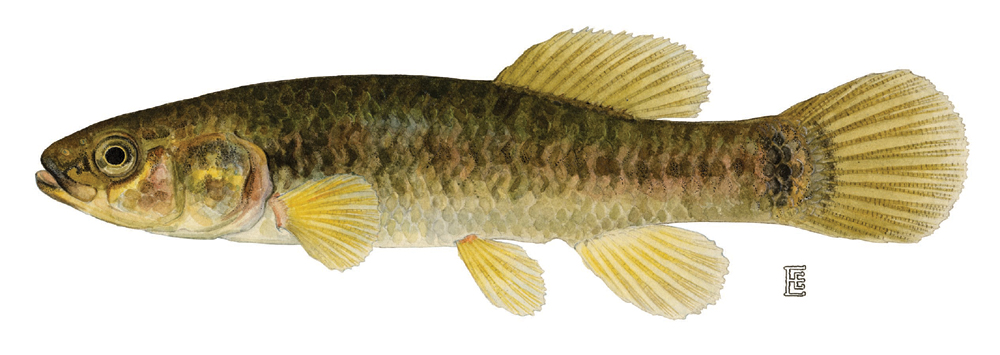
Central Mudminnow fish (Umbra limi) are found both in The Great Lakes and in Southern Ohio and other regions of the state.
This species is known to reduce the population of zooplankton in its natural habitats of lakes and ponds.
Central Mudminnows are one of the few species that begin spawning in the spring, in April. This is due to the fact it chooses shallow warm waters at the margins of lakes.
While females are larger than male Central Mudminnows, both are small compared to the average Ohio species.
They only reach a maximum length of 3.9 inches.
30. Greengill Sunfish

A small flat type of fish in Ohio is The Greengill Sunfish (Lepomis macrochirus × cyanellus).
This is a dark-colored species that are almost black. Even its fins are all-black.
Some of the largest Greengill Sungish measure more than 10 inches. On average, this species only measures around 6 inches.
A common sight in ponds, this species is seen in lakes and the streams connected to lakes.
The species eats insects and larvae when young. It may also eat small fish as an adult, especially in the case of larger adults that can swallow whole fish.
31. Banded Darter

Banded Darters (Etheostoma zonale) are a type of fish found in streams and small rivers of the state. With stable populations, there are no active management plants tied to the species in Ohio.
These fish prefer rocky river beds and stream bottoms. They only seek out the deepest parts of the rivers and streams when spawning.
Eggs are laid on algae in the deepest parts of these rapid waters.
Banded Darter fish eat different types of dipterans and fly larvae.
They prefer shallow water to catch flies and move away from the deepest areas with waterweed where they spawn.
Some of these fish may easily be spotted resting in slow areas of the upstream waters behind boulders.
32. Spotfin Shiner

Small size is specific to Spotfin Shinne (Cyprinella spiloptera). These are gray-silver fish that are found in some of the largest rivers of the US such as The Potomac River and smaller rivers in Ohio.
The species grows to a few inches and it can be found in rapid streams and rivers with rocky bottoms.
Anglers catch these small fish to use as bait for larger fish. They do this by using flies as the species is a known insectivore.
It mostly feeds on insects that fall or rest on the surface of the water. The species may also occasionally feed on small water organisms.
33. Walleye

Sometimes referred to as the Yellow Walleye (Sander vitreus), this is s fish with a yellow, green, or olive color.
This is one of the better-known predators of North America which have a special status across multiple states.
Anglers look for Walleye as one of the species to catch and eat. This species is subject to management rules and it may be limited to catching quota in some parts of the state.
Walleye lay many more eggs compared to other species.
A female fish can lay as many as 100.000 eggs. These eggs stick to the rocks or the plants at the bottom of the water.
Unlike other species, both males and females move on without guarding the eggs.
Freshly-emerged Walleye can only eve plankton and larvae at first.
34. White Crappie

White Crappie fish (Pomoxis annularis) is a small species with direct connections to Black Crappie. Their habitats may intersect.
This is a species that grows to an adult size of at least 6 inches. It has a gray-silver color with black molting.
Most White Crappie that reaches adulthood goes on to survive at least a few years as many fall prey in their young years.
The species is found in some of the most difficult conditions as they have adapted to turbid habitats.
35. Warmouth

With the capacity to survive polluted waters, Warmouth (Lepomis gulosus) is among the resilient but less common species found in the state.
These fish have a flattened shape and they grow to a size of around 5 inches weighing around 2 pounds as adults.
In their first year, they only eat crustaceans, fish eggs, and various larvae.
Shrimp is one of their preferred foods once they reach adulthood.
Hiding in dense vegetation, this fish relies on ambushing techniques to catch its prey and also to escape predators such as snakes.
36. Longnose Gar

Longnose Gar (Lepisosteus osseus) is some of the largest types of fish in the state that live in deep areas of lakes.
These types of fish have a primitive nature showing different rare traits compared to other modern or evolved species.
They have a dark green color and an elongated snout with large teeth.
The diet of Longnose Gar differs from one area to another but mainly consists of fish. Sunfish is one of its most common types of prey.
37. Golden Shiner

Golden Shiner fish (Notemigonus crysoleucas) has a golden-orange color and are found in The Great Lakes.
They show high adaptability to high and low temperatures as they are also confirmed North of Ohio in Canada.
A flattened body and a diet that’s mostly based on zooplankton are specific to this species.
Golden Shiners are some of the most common types of prey for trout in Ohio.
38. Common Logperch

Common Logperch (Percina caprodes) is among the small species in the state that suffer from human impact.
Polluted waters, pesticides, and lower water oxygen levels are among the main reasons this species is facing lower numbers.
Dams across the state impact the species directly as they reduce oxygen levels.
Found in rocky substrate areas, this species has yellow, golden, or brown color with black dorsal bands.
39. Round Goby

Round Goby fish (Neogobius melanostomus) invading Northern parts of Ohio have a detrimental role on the ecosystem.
These types of fish outcompete local and native species for food. Accidentally introduced from Europe, these fish mostly reduced snails as a food source.
Occasionally, these invasive fish also eat mussels but they are also prey for larger bass.
40. Grass Carp

Grass Carp (Ctenopharyngodon idella) represent one of the most popular invasive species of carp in North America, with an Ohio presence.
This is a large fish with a flattened appearance which may have a positive role in the ecosystem in some areas.
It mainly eats the vegetation. Aquatic vegetation is almost eliminated in areas with plenty of Grass Carp, which is why some fishermen release them as they get caught.
On occasion, this type of fish may also eat insects and other aquatic organisms.
41. Stonecat

Stonecat fish (Noturus flavus) are named after their habits of living in areas with plenty of rocks in rapid waters.
Streams and small rivers are the places where these elongated thin fish that reach a size of 11 inches live.
As an opportunistic feed, Stonecat fish can eat almost all types of small fish and insects.
Often found in creeks, these fish are also confirmed in The Great Lakes.
One of the benefits of established Stonecat populations is assessing water purity levels. These fish can only live in pure waters that aren’t polluted.
42. Sand Shiner
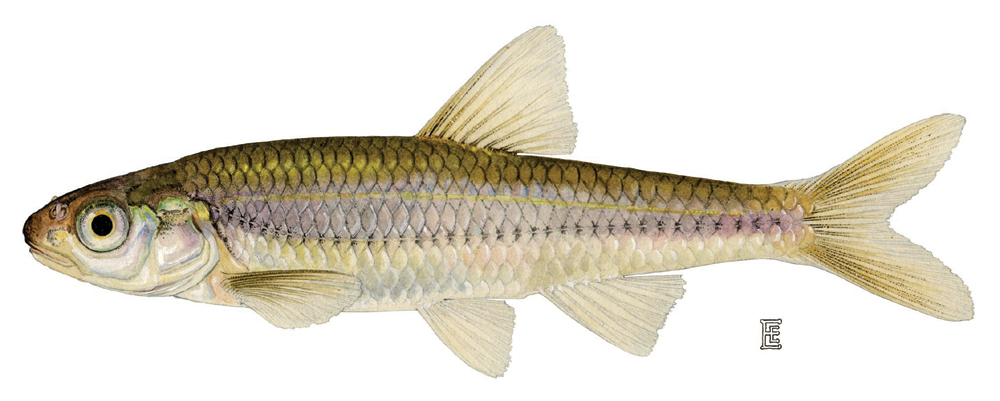
Sand Shiner (Notropis stramineus) live at the bottom of lakes in sandy areas. They are established in The Great Lakes.
While found at great depths, these fish are omnivores.
Different types of aquatic insects are mostly eaten by Sand Shiner.
They also eat insects and various aquatic organisms they can find in the streams connected to lakes in their habitats.
43. Blackstripe Topminnow
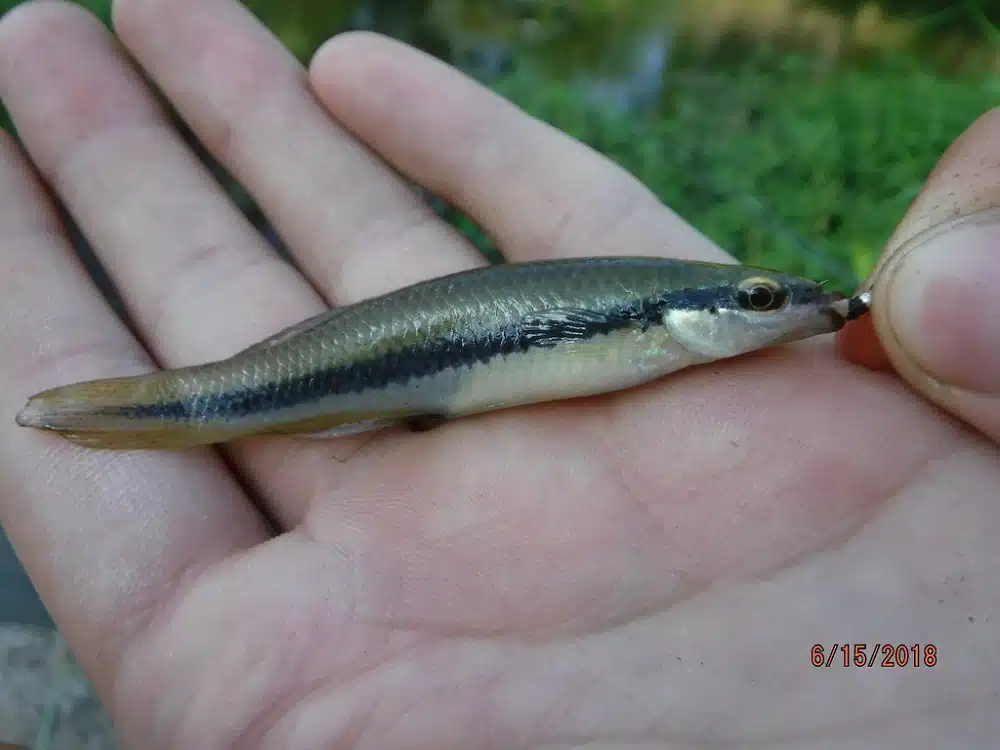
Slow current areas of Lake Erie represent one of the main habitats of the Blackstripe Topminnow (Fundulus notatus).
This species is named after the black lateral stripe on the sides of its body.
In their quest for slow waters, these fish may also look for areas with plenty of aquatic vegetation.
Blackstripe Topminow fish live close to the surface of the water where they look for insects to feed on.
44. Common Shiner

Common Shiner fish (Luxilus cornutus) is a small species that measures up to 6 inches.
A silver or a dark silver color is specific to the species. While small, Common Shiner lives up to 6 years.
Fish of this family are found in lakes and ponds. They are also found in some of the largest lakes of the state, mainly on the edges of shallow water.
Unlike Blackstripe Topminnow which only lay a few eggs per year, female Common Shiner lay thousands of eggs each year.
45. American Pickerel

American Pickerel (Esox americanus) is one of the common predators in lakes and rivers of the state.
Found in The Great Lakes and rivers, these long slim fish are known predators and prey for local species.
American Pickerel fish feed on small species and they are also eaten by other larger predators such as striped bass.
With an average weight of 2 pounds as adults, these types of fish are a moderate prize for anglers.
46. Silverjaw Minnow

Some of the smallest fish in the state are Silverjaw Minnows (Notropis buccatus). These fish have a gray-silver color, as the name implies.
They live in rivers, ponds, and lakes. These fish are also confirmed around The Great Lakes.
Insects form the bulk of their diet. Midges and mayflies are some of the insects these fish can catch.
These fish can spit out the types of insects they don’t like the taste of.
47. Redear Sunfish

A popular species with anglers, Redear Sunfish (Lepomis microlophus) represents one of the oldest species of fish in the world.
Traces of the species going back millions of years have been discovered.
The family of fish is known for feeding on snails, mussels, and zooplankton.
To a lesser extent, Redear Sunfish also eat aquatic vegetation such as various algae.
You can find these types of fish in lakes and streams. Most fish of the species live social lives as they’re seen in groups in areas of the lake with plenty of vegetation.
48. White Bass

A common sight around The Great Lakes, White Bass (Morone chrysops) represent a species that grows to 11 inches.
Silver coloring is specific to this species which also has a slightly-flattened body.
These fish have adapted to cold Northern winters, especially by eating more to survive the colder months when they might not eat at all.
White Bass are also found in upstream areas of streams, but to a lesser extent.
Spawning takes place in shallow water which is also where young fish live before reaching adulthood.
49. Northern Sunfish

A colorful species, Northern Sunfish (Lepomis peltastes) are known to come in white and red coloring in a main morph.
This type of sunfish has a complex diet compared to sunfish in other areas of the US. It eats insects such as mites.
Small streams around Northern Ohio represent the main habitat of the species.
Northern Sunfish prefer slower-moving streams which are rich in either rocky bottom areas or sandy bottom areas.
50. Emerald Shiner

Emerald Shiner fish (Notropis atherinoides) grow to a size of up to 4 inches.
These fish are some of the common planktivores of Ohio and the Northern states. They eat zooplankton and are often used as a food source for animals.
Adapted to cold Northern winters, Emerald Shiner retreat to deeper water in cold weather. They return to shallow waters with rocky or sandy bottoms from spring to fall.